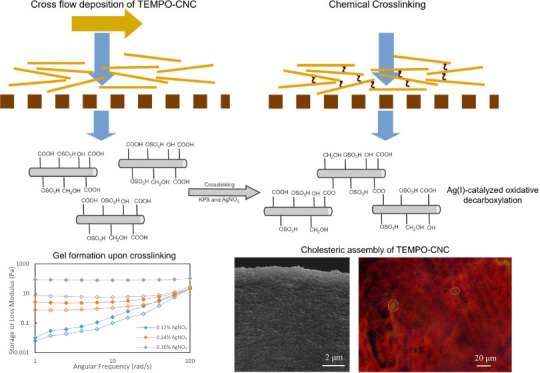- Record: found
- Abstract: found
- Article: found
Cross-Linked Cellulose Nanocrystal Membranes with Cholesteric Assembly

Read this article at
Abstract

Forming membranes by tangential flow deposition of cellulose nanocrystal (CNC) suspensions is an attractive new approach to bottom-up membrane fabrication, providing control of separation performance using shear rate and ionic strength. Previously, the stabilization of these membranes was achieved by irreversibly coagulating the deposited layer upon the permeation of a high-ionic-strength salt solution. Here, we demonstrate for the first time the chemical cross-linking of carboxyl-containing TEMPO-oxidized CNCs by Ag(I)-catalyzed oxidative decarboxylation and the stabilization of CNC membranes using this post-treatment. Cross-linking of TEMPO–CNCs was first demonstrated in suspension via turbidity, dynamic light scattering, and storage ( G′) and loss ( G″) moduli measurements. Membranes were formed by filtering a 0.15 wt % TEMPO–CNC suspension onto a porous support, followed by permeation of the cross-linking solution containing AgNO 3 and KPS through the deposited layer. Rejection for Blue Dextran with a 5 kDa molecular weight was 95.3 ± 1.9%, 90.6 ± 3.7%, and 95.9 ± 1.0% for membranes made from suspensions of TEMPO–CNC, desulfated TEMPO–CNC. and TEMPO–CNC with 100 mM NaCl, respectively. Suspensions with added NaCl led to membranes with improved stability and cholesteric self-assembly in the membrane layer. Membranes subjected to cross-linking post-treatment remained intact upon drying, while those stabilized physically using 200 mM AlCl 3 solution were cracked, demonstrating the advantage of the cross-linking approach for scale-up, which requires drying of the membranes for module preparation and storage.
Related collections
Most cited references37
- Record: found
- Abstract: found
- Article: not found
The shape and size distribution of crystalline nanoparticles prepared by acid hydrolysis of native cellulose.
- Record: found
- Abstract: not found
- Article: not found
Chemically Cross-Linked Cellulose Nanocrystal Aerogels with Shape Recovery and Superabsorbent Properties
- Record: found
- Abstract: not found
- Article: not found